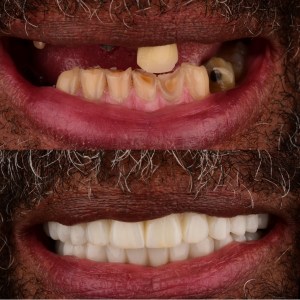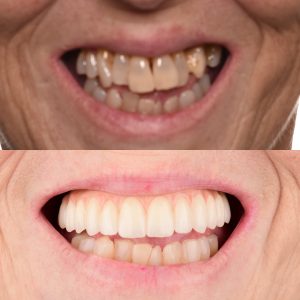Dental Implant Procedures: Before & After
Last updated Thursday, August 31st, 2023
See How Dental Implants Can Transform Your Smile
A tooth with weak roots is bound to fall. All your cleaning and scraping won’t do any good if your tooth is damaged to that extent. Maintenance can’t save it anymore because it needs restoration. You need a dental implant, which is a tooth root substitute surgically implanted in your mouth.
A dental implant is essentially a metal post that looks like a tiny screw, which will support your new artificial tooth or dentures.
 This simple procedure is accomplished in two stages:
This simple procedure is accomplished in two stages:
- Surgically implanting the screws in your upper or lower jaw
- Fitting your new dentures supported by the screws once they have properly fused into your jawbone
It’s a one-time intervention for a lifetime of picture-perfect smiles.
Dr. Mansoor uses state-of-the-art technology to examine your dental conditions and give you a fully customized smile design. This allows us to give restore your natural smile. We like to go the extra mile to give you more reasons to smile. Because we know the suffering our patients go through to need implants. They have to go through severe tooth decay, gum disease, accidents, infections, facial changes, or even life-threatening conditions.
Our treatment aims to make you permanently problem-free in the most pain-free way.
Based on the severity of your dental damage, you can choose from different types of implants like:
- Single dental implants
- All-on-6 dental implants
- All-on-5 dental implants
- All-on-4 dental implants
You have to see it to believe it to understand how dramatically they can improve your dental health. In this blog, we’ll be discussing the impact each type of dental implant can have on your life.
Ready to Get Your Beautiful Smile?
CALL (480) 780-1511
Take control of your life and give yourself the smile you deserve! With our New Patient Special, the time to book your appointment for your dental implants is now!
All-on-6 Implants: Upper and Lower Jaw
The all-on-6 dental implant consists of two main parts – anchors and an arch.
The anchors are meant to serve as your new tooth roots. Six titanium screws are fitting into your lower or upper jawbone. Now that the foundation is strong and stable, a dental arch is installed on top of them. It consists of false gums integrated with porcelain or ceramic dentures. They are screwed onto the anchors to hold them firmly in place.
Anchors – Six titanium screws are strategically fitted into the lower or upper jawbone to hold the dentures in place
Arch – False gums supporting porcelain or ceramic dentures are screwed onto the anchors.
All-on-6 implants are ideal for patients with severe tooth damage and multiple missing teeth. It’s more than filling in the gaps; it rebuilds your whole smile.
For example – a lady who had to get rid of most of her teeth due to periodontal disease wanted a permanent solution. She was given a sinus lift and bone graft procedure to prepare her jaw bones for the implants. She was given 6 implants in each jawbone and a full set of Zirconium teeth. She loved the massive aesthetic improvement and ease of being able to chew her favorite foods again.
All-on-4 Implants: Lower Jaw
All-on-4 implants are similar in procedure to all-on-6 implants. However, they’re given to patients with slightly lesser damage compared to those who get all-on-6 implants.
Dr. Mansoor will install two implants in the front of the mouth and two near the back. These four tilted implants can support a dental arch that works as smoothly as your natural set of teeth.
For example – a patient with multiple falling teeth and loose teeth in his lower jaw came in for an appointment. All his damaged teeth were extracted first in a pain-free way after sedating him. He received his implants and his new teeth on the same day. He woke up to a glowing smile and a comfortable eating experience after 15 years of struggle.
All-on-5 Implants: Upper Jaw

All-on-5 dental implants can also increase your natural bite force by more than 70%. So now you can eat fearlessly and keep up your sparkling smile with basic oral hygiene.
For example – a patient who had been toothless for ten years wanted a permanent solution. She had gone through two failed attempts to replace her missing upper teeth earlier. She was given a sinus graft to restore her jaw bone volume. She was finally given 5 implants in her upper jaw. She was delighted to see her youthful smile in the mirror and smile around her grandchildren confidently again.
Front Tooth Implants: Restoring Your Smile
Front tooth implants are a great option for anyone with missing or damaged front teeth. You just have to go through a quick and non-invasive surgery to fill in the gaps. Your new artificial tooth will look better than the real one seamlessly integrated with your gums. Expect a much faster healing process compared to all-on-6, all-on-5, and all-on-4 implants. You’ll be able to continue your daily activities without any disruptions.
For example – a patient lost one of her front teeth because of an infection. The dentist safely extracted the tooth, cleaned the infected area, and replaced it with a beautiful porcelain tooth on the same day.
Front Teeth Implants: Veneers and Orthodontic Therapy
Getting a front teeth implant means you’ve laid a fixed foundation for your teeth. You can’t move it, but you can still do a little superficial work to achieve the perfect smile. Sometimes you may want to improve your new tooth’s alignment and make them whiter.
Think about it. What’s the point of a perfectly straight implant in a row of crooked teeth? How can you fix this? By using orthodontic therapy. You can use braces even if you’ve received multiple front teeth implants. You can also use veneers to improve your tooth color if you want.
For example – a patient had multiple gaps in her front teeth and some of them were stained due to her smoking habit. Getting a front teeth implant didn’t fix this problem. However, it made it easier to use Invisalign braces. She also got some veneers to conceal the stains on her teeth. She was delighted to see how this treatment closed the gaps and whitened her teeth to give her the perfect smile.
Front Teeth Implants: Congenitally Missing Cases
Do you have congenitally missing teeth? It simply means you were born without certain teeth. It’s common for a lot of people to be born without wisdom teeth. But it turns into a problem when you’re missing your incisors or premolars.
A dental implant has one of the highest success rates in fixing this problem. It blends in with your adjacent teeth and gives you the aesthetic smile you were always longing for. The best part is they require little maintenance and will last your whole life.
For example – a patient with missing lateral incisors was two front teeth implants. He had to undergo bone grafting surgery to prepare for the implants. The implants were perfectly placed in alignment with the rest of his front teeth. He also opted to get veneers on his front two teeth to match the color of his beautiful new dental implants.
Multiple Dental Implants and Veneers in the Lower Jaw
Having multiple missing teeth in your lower jaw doesn’t mean you need to get individual implants for each of them. You can install implants at the ends of the tooth gap and set up a dental bridge across the gap. It gives you a stable set of dentures by lowering your treatment time and expenses.
People who have had missing teeth for several years often face a lot of bone loss. In that case, you may need to get bone grafting before the implant procedure.
For example – a man who was born with multiple missing teeth in his lower jaw solved his issue with two implants. His dentures filled in the gaps and a little veneer work on his surrounding teeth helped his new teeth blend in perfectly.
Multiple Dental Implants and Veneers in the Upper Jaw
You can follow the same procedure as above to deal with missing teeth in your upper jaw. The only difference is the implants will be installed in your upper jaw bone. Most patients are able to recover fully within two weeks. However, it takes three to six months for the implant to fully bond with your jawbone.
For example – a man with three missing front teeth in his upper jaw requested an intervention after getting into an accident. He received a three-unit implant bridge that permanently solved his issue along with some veneers to upgrade his smile.
Full Mouth Rehab and Veneers
A full mouth rehabilitation is a lot like going through a complete home renovation. It sounds intense and complex, but technology has enabled us to rebuild your smile from scratch. We help restore your healthy oral tissues and structure your teeth using multiple procedures.
It could include implants, crowns, veneers, bone grafting, and other procedures. The process takes multiple sittings to accomplish, but the results are astounding. It could last anywhere between a few months to two years depending on your treatment cycles.
For example – a patient with multiple missing teeth, severe tooth decay, and crooked teeth wanted a total smile makeover. He was given metal-free dental crowns, porcelain veneers, bridges and Invisalign braces to fix all these issues. It took slightly over four months to give him the dreamy smile he came for.
Get Started On Your New Smile
It's time you stop putting off your next dental visit. Whether it's a general check-up or a complex restorative or cosmetic procedure, the time to book your appointment is now!


